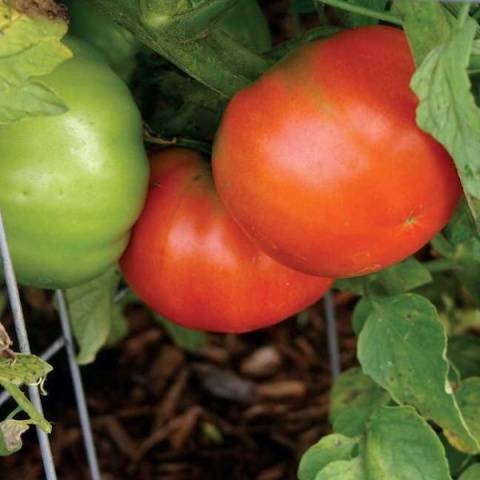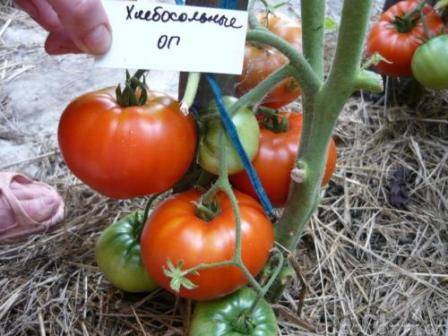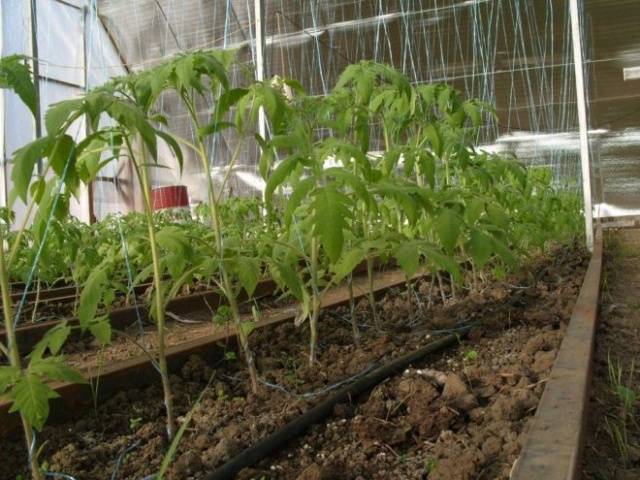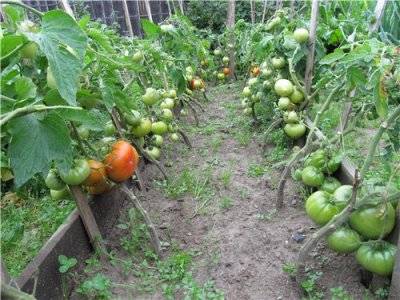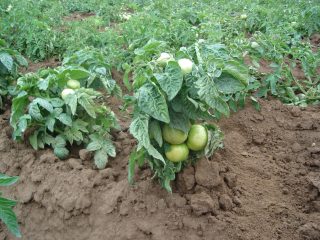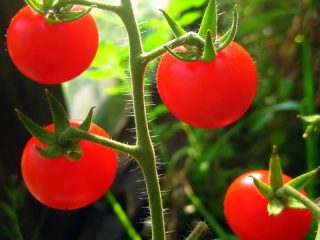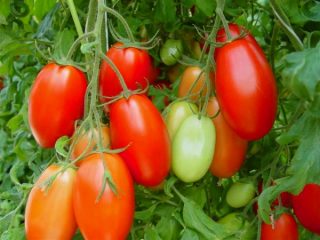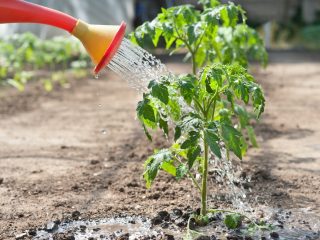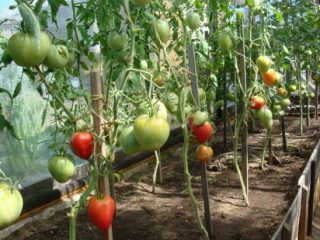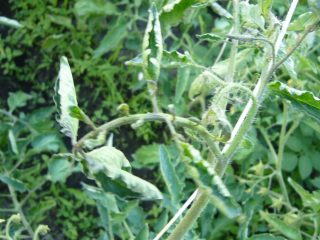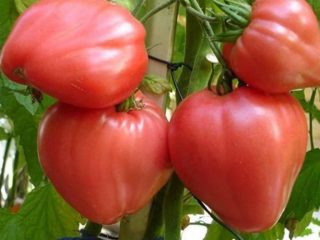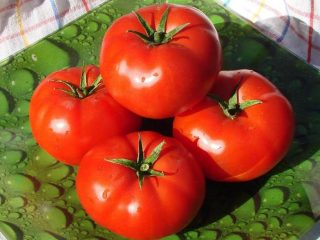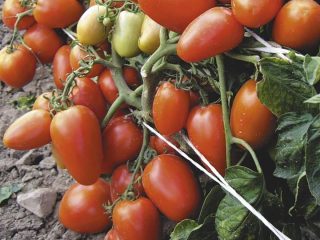Content
The Siberian selection tomato is fully adapted to the local climate. The plant's strong immunity allows you to grow tomatoes in any unfavorable conditions and still reap large yields. The Hospitable tomato is also famous for its excellent taste of fruit. All these characteristics have made the vegetable in demand by many vegetable growers.
Fruit characteristics
Let's start looking at the description and reviews of the Khlebosolny tomato with the fruit. After all, many vegetable growers are primarily concerned with the quantity and quality of the harvest. The breeders have done their best in this regard. Firstly, the variety turned out to be large-fruited. On average, one tomato weighs about 600 g. Fruits weighing from 300 to 800 g can ripen on a bush. On the lower tier, with good feeding, giants weighing up to 1 kg grow. Secondly, the taste of the tomato is of great value. The fleshy pulp is quite sweet, juicy, but not watery. The skin is strong and thin. When eating the fruit, it is practically not felt.
Tomatoes grow round in shape with a flattened top and an area near the stalk. Faint ribbing is visible on the walls. The seed chambers of the fruit contain few grains. When a tomato has reached full maturity it becomes red with a pink tint.
The Khlebosolny variety is considered a salad variety. The fruits are used for decoration, as well as for preparing dishes, especially dietary and children's dishes. Tomatoes can be processed. The fruit makes excellent juice, thick paste or ketchup. Tomatoes are not used for canning. The dense pulp and skin will withstand any heat treatment, but due to its dimensions, the fruit simply will not fit into the neck of the jar.
Characteristics of the bush
Continuing to consider the characteristics and description of the Khlebosolny tomato variety, it is time to get acquainted with the above-ground part of the crop. The bush is determinate, although it can grow in height from 0.8 to 1 m. The plant is very spreading. Tying the stems to the support is required. Additionally, you need to support heavy fruits so that the brushes do not break off the branches.
The variety is considered mid-season, since the ripening of tomatoes begins on the 120th day. In the south and in the middle zone, the Khlebosolny tomato can be grown outdoors. In the northern regions, the closed method is more suitable. And it doesn’t matter what the greenhouse is made of. The Khlebosolny variety grows well under film, glass or polycarbonate.
Tomatoes of Siberian selection are famous for their resistance to poor growing conditions. The Khlebosolny variety is not lagging behind in this regard. The plant easily tolerates dry summers, temperature changes and sudden cold snaps. The tomato is slightly susceptible to fungus, rot and other viral diseases.
Agricultural technology of culture
If photos and reviews about the Khlebosolny tomato have convinced you that you need to grow this variety, then you need to familiarize yourself with the conditions of agricultural technology.
Growing seedlings
By their origin, Khlebosolnye tomatoes are not a hybrid. This gives the vegetable grower the right to grow tomatoes from his own seeds. To obtain good germination, you need to collect high-quality grains from the tomato. The fruit left for seed is allowed to fully ripen on the bush. Next, the tomato is picked and placed on the window to rest for at least two weeks. When the fruit is completely overripe, it is cut with a knife and the seeds are extracted from the pulp. You can do this with a teaspoon. The grains are raked out from the seed chambers of the tomato, washed with clean water, and then dried well.
This positive feature allows a vegetable grower in the southern regions to plant tomato seedlings not into cups, but directly into the garden bed. To protect young plants, you only need to build a temporary film shelter.
Tomato seeds are sown in early April, provided that the seedlings are planted in the garden from mid-June. With the closed method of growing tomatoes, seeds are sown for seedlings around February 15th.
Homemade tomato seeds are soaked and pickled before sowing. Store-bought seeds have undergone all these procedures in production, so they can be sown directly from the pack. Tomato seedlings are grown in common containers or individual cups. It is better to buy soil in a store. If soil is collected from the garden, it is disinfected by calcining it in the oven and wetting it with a solution of potassium permanganate.For nutritional value, humus is added to the soil before sowing.
Tomato seeds are immersed to a depth of 2 cm, the containers are covered with film and left in a warm room with a temperature of about 25OC. Watering is carried out only from a sprayer with warm water. High-quality tomato seeds should germinate no later than 7 days. After the shoots emerge, the film cover is removed and the seedlings are placed on the windowsill. There will be little daylight for tomatoes, so fluorescent lamps are fixed above the plants.
Tomato seedlings growing on the windowsill are turned towards the light every day. If you do not do this, the plants will turn out to be curved towards the window glass. After two full-fledged leaves grow, the tomatoes dive. Before planting in open ground, it is necessary to harden the plants. To do this, the tomatoes are taken outside into the shade. Hardening begins from 1 hour, gradually increasing the time over two weeks.
The video talks about Khlebosolny tomato seeds:
Transplanting
Tomato seedlings are considered complete when the plant grows from 6 to 8 full leaves and the first inflorescence appears. The bed for tomatoes is prepared in the fall. Humus is added to the soil and dug into the soil. It is advisable that organic matter consist of cow manure and rotted leaves. If the bed has not been prepared since the fall, this can be done a month before planting the tomato seedlings.
Tomatoes are planted in the evening or early morning. It is advisable that the day be warm, and not hot or cold. Holes are dug according to the size of the tomato root system. The earth is first watered with a pale solution of potassium permanganate for disinfection, and then a tablespoon of complex fertilizer is added. A tomato seedling removed from a glass is placed in a hole along with a lump of earth.The voids are filled with loose soil, after which another watering is carried out with warm water.
The Hospitable pink tomato grows as a spreading bush. At 1 m2 you need to plant a maximum of four tomatoes, but it is better to reduce their number to three plants. The Hospitable variety loves light and fertile soil. Heavy soil can be loosened by adding river sand. A good fertilizer is leaf humus taken from the forest. The Khlebosolny tomato responds well to watering with a solution consisting of 1 part ash and 10 parts mullein.
Caring for tomato plants
The yield of tomato variety Khlebosolnye reaches 8.5 kg of bush or more, which depends on care. The fruits are quite heavy. To prevent the tomatoes from breaking off the branches, place supports under the brushes. It is better to tie the stems to a trellis.
Taking into account the reviews about the Hospitable tomato, let's look at the rules for caring for the crop:
- In addition to tying it to a support, the tomato bush needs to be shaped. This is not necessary, since the plant is determinate, but favorable weather conditions may cause severe thickening. The formation provides for the standard removal of excess stepsons. The bush grows with one or two stems.
- When the tomato stem reaches 80 cm in height, pinch off the top of the plant. The lower tier of foliage must be torn off.It covers the fruits, retains dampness under the bush and draws excess juices from the plant.
- The Hospitable variety tolerates lack of moisture, but the plant still requires water. In hot, dry summers, tomatoes need plenty of watering at least once a week. It is advisable to use warm water from a storage tank. You can dissolve some wood ash. When watering, it is undesirable for water to get on the leaves of tomatoes.
- After each rain or watering, the soil around the tomato bushes is loosened. In order to conserve moisture during dry summers, the ground near the plants is covered with mulch.
- Organic matter and complex fertilizers are applied after watering. Tomato Khlebosolny reacts well to potassium and phosphorus, but you should not overdo it with nitrogen. During tomato flowering, it is advisable to use boron for feeding. After the ovary appears on the lower tier around the bushes, the ground is crushed with ash. It will protect tomatoes from pests. For prevention, sometimes vegetable growers resort to spraying tomatoes with a solution of boric acid.
When growing tomatoes, you should not be greedy with the fruits. Starting from mid-August, all emerging flower stalks are cut off. The fruits from them will not have time to ripen anyway, and the excess juices will be drawn from the plant.
Reviews
At the end of the review of the variety, let's read about tomatoes. Hospitable reviews from vegetable growers and ordinary summer residents.
